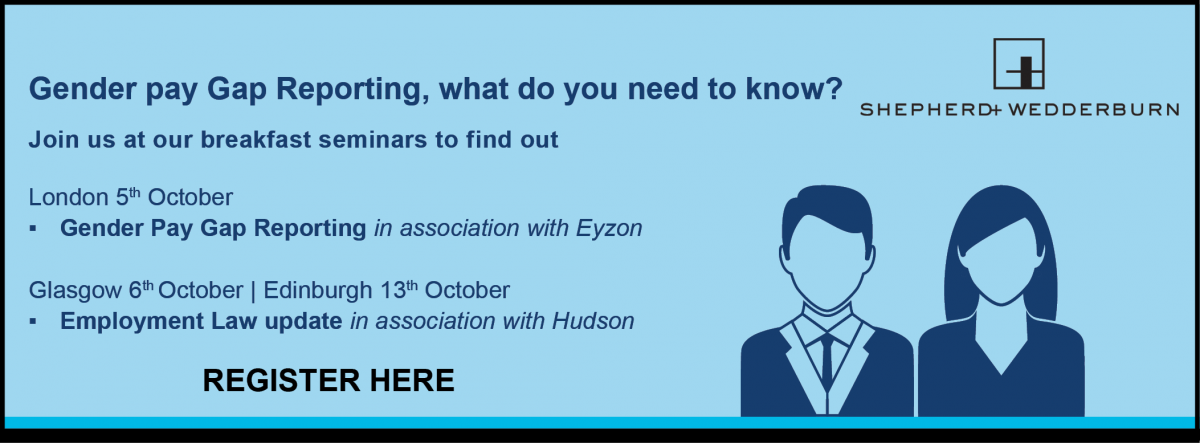
Contributors: Neil Maclean
Date published: 14 June 2016
Apprenticeship levy: are you levy-ready?
Following an initial announcement in the 2015 Summer budget, and the publication of draft legislation in February 2016, the Government is set to introduce an apprenticeship levy with effect from 6 April 2017. But what is it and who does it affect?
The purpose of the levy is to fund and facilitate increased numbers of apprenticeships in the UK. It will be applied to all employers in the UK, across all industries, and is payable regardless of whether the business currently has or intends to have any apprentices. It is payable at the rate of 0.5% of the employer’s total wage bill. All employers will, however, receive an offset allowance of £15,000, meaning that only employers with an annual wage bill in excess of £3m will have to pay the levy. The government has stated that, as a result, only 2% of employers in the UK will be liable to pay. However, given that an employer with 125 employees on average salaries of £25,000 would have a wage bill in excess of £3m, this is clearly not an issue only for the largest employers.
The levy will be paid through the PAYE system, in the same way as income tax and national insurance. In calculating an employer’s annual wage bill, all remuneration relating to employment will be relevant including salary, bonus, commission payments and pension contributions, but excluding benefits in kind. Groups of companies will only be able to use one £15,000 allowance between them, and it is up to the companies within the group to decide what proportion of the allowance each company will be entitled to for a given tax year.
How will the funds be used? As apprenticeships are a devolved matter, how the levy will be used to fund apprenticeship training in each of England, Scotland, Wales and Northern Ireland will vary. So far, the Scottish Government and Welsh and Northern Irish Assemblies are yet to determine how the levy will be used in their part of the UK.
We do however know how the levy will be used in England. In England, a digital apprenticeship service account will be set up, and UK employers with employees in England, who are liable to pay the levy, will be able to access funding through their own personal account. This funding can then be used to pay for training and assessments for apprentices in England (but not an apprentice’s wages, which would have to be met by the employer separately from the levy). The amount of funding an employer will be able to access will be calculated as a proportion of the levy which they have paid, based upon the proportion of their wage bill which is paid to employees living in England. Therefore, for an employer with all of its employees in England, the funds available will be equal to the full levy which they have paid. If only 50% of its employees are in England (with the other 50%, for example, in Wales or Scotland), the funds available under the digital account in England will be equal to 50% of the levy it has paid. However, in addition, the government will apply a 10% top up on all funds through the English system, meaning that for every £1 an employer pays into the scheme, they will receive £1.10 back to fund English apprenticeships. Funds will however expire 18 months after they have been paid into an employer’s digital account, if they haven’t been spent. The UK Government also plans to establish a new body, the Institute of Apprenticeships to support employers to uphold the high quality of apprenticeship standards in the context of the apprenticeship levy. The IfA will be an employer-led statutory body tasked with ensuring high quality standards in apprenticeships. The UK Government is also intending to regulate the use of the word “apprenticeship” to cover only government accredited schemes.
Funds from the apprenticeship levy fund will be allocated to each of Scotland, Wales and Northern Ireland, and it will be for the Scottish Government and the Welsh and Northern Irish Assemblies, to determine how the levy is spent in respect of apprenticeship schemes in those countries.
Therefore, it will remain to be seen whether, in Scotland, a similar system to the English one will be introduced, or whether the Scottish Government will, for example, hold the funds centrally to be distributed to employers who wish to take on apprentices in the form of grants, or to fund Government-run apprenticeship training programmes, rather than individual employers each being allocated their own funding, as under the English system.
Implications for employers The apprenticeship levy has, perhaps unsurprisingly, not been welcomed with open arms by many employers. For medium sized employers, this could represent a significant additional cost at a time when the economy is still very much in recovery. For some of the UKs largest employers, the levy could run into millions of pounds, and is unlikely to ever be fully recoverable through recruitment of apprentices. Some employers will be used to taking on apprentices, and may now decide to do so in increased numbers, to make full use of the levy they are paying. There may be others, however, which are liable to pay the levy but have never taken on apprentices in the past. They may now need to consider whether this is something they should be doing, in order to benefit from the levy. Whether an employer intends to recruit apprentices or not, the levy is a significant additional cost many employers will now face in the coming years, which need to be considered and planned for now.

Contributors:
Neil Maclean
Partner and Head of Employment
To find out more contact us here













